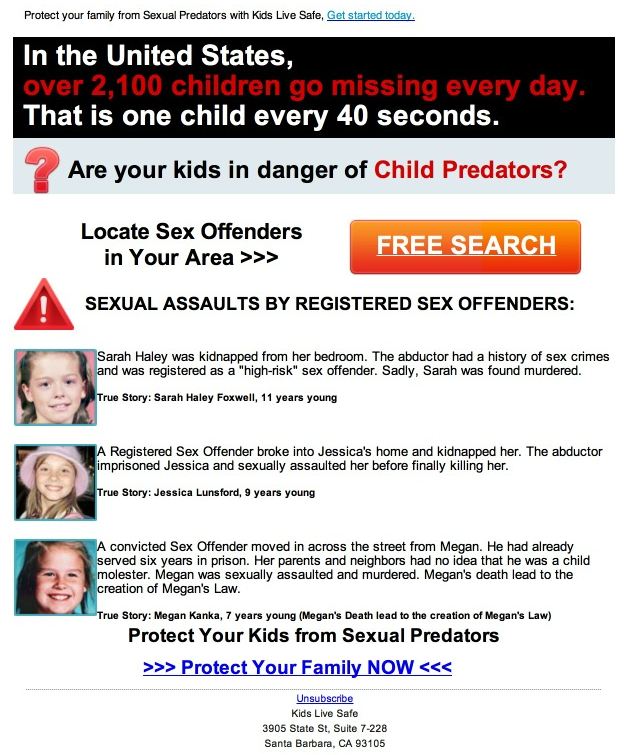Here is a typical example of the kind of spam sent out to inspire fear in parents that their children are constantly under threat of being abducted by a sexual predator. I received this today. The From line was “Child Predator Alert” and the subject line was “Child Predator Warning in Your Area“.
This particular outfit is commercial in nature, capitalizing on the sex offender paranoia to get you to send them $30 per month for membership, but their tactics of abusing statistics in order to intentionally mislead the public is a common practice among many NGOs crusading for a myriad of different causes (many of which leverage off the idea that children are under some kind of over-blown threat).
But what about the claims in this message?
No one likes statistics more than an NGO trying to justify its existence. People believe them. If you go to the Kids Live Safe website, you will find that they cite the U.S. Justice Dept as the source for their facts, but rather than link directly to the actual Justice Department study, they link to other NGOs.
The Justice Department study overview can be found here.
The most common abuse practiced by organizations such as this is the conflation of statistics to intentionally get you to misinterpret them. In this case they conflate the number of children who go missing with abductions by placing the statistic next to the pictures of three highly publicized extreme cases of children who were kidnapped and murdered. The 2100 figure comes from the total number of children reported missing in one year (~800,000 per year divided by 365 days).
Although runaway/thrownaway children reflect a substantial minority of reported missing children (45 percent), nearly as many children (43 percent) became missing because of benign reasons. Comparable percentages of reported missing children were missing because they were lost or injured (8 percent) and because they had been abducted by a family member (7 percent). Only a small percentage were missing because of a nonfamily abduction (2 percent).
Parents who are interested in knowing about sex offenders living nearby, are more likely worried about non-family (stranger) abductions, which account for only 2% of that total. Stand by. It gets even sleazier.
Here is what the report says about the kind of serious kidnappings that the spam message illustrates with its tree examples:
Stereotypical kidnappings. In table 3, the estimates for nonfamily abducted children include primarily crimes involving a modest amount of forced movement or detention that correspond with the way in which abduction is legally defined in most State statutes. Such abductions are rare enough that the estimates of the number of caretaker missing and reported missing children abducted by a nonfamily perpetrator are not very reliable and have very large confidence intervals. Stereotypical kidnappings are the particular type of nonfamily abduction that receives the most media attention and involves a stranger or slight acquaintance who detains the child overnight, transports the child at least 50 miles, holds the child for ransom, abducts the child with intent to keep the child permanently, or kills the child. They represent an extremely small portion of all missing children. (The Law Enforcement Study found that an estimated 115 of the nonfamily abducted children were victims of stereotypical kidnappings and that 90 of these qualified as reported missing.)
The emphasis is mine. Ninety reported stereotypical kidnappings for the entire year falls a little short of the 2100 per day that the message cites.
I should also point out that this business gets an A rating by the Better Business Bureau, which makes an interesting statement about the BBB.
